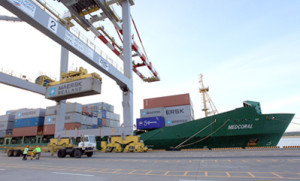 Coming off a 120% surge in fourth-quarter box throughput last year, Batangas Container Terminal (BCT) expects volumes will rise further this year, especially if importers and exporters wield “locator power” to influence carriers and freight forwarders to use the port for Calabarzon cargoes, listed Asian Terminals Inc. (ATI) said in a statement.
Coming off a 120% surge in fourth-quarter box throughput last year, Batangas Container Terminal (BCT) expects volumes will rise further this year, especially if importers and exporters wield “locator power” to influence carriers and freight forwarders to use the port for Calabarzon cargoes, listed Asian Terminals Inc. (ATI) said in a statement.
The port operator said BCT’s box throughput trend continued in January and February with 110% growth year-to-date driven by weekly imports from Singapore and weekly exports to Taiwan and China from manufacturers in Cavite, Batangas, Laguna, Rizal, Quezon.
“The growth comes from a small base, but is extremely promising for the port and also for the Calabarzon import-export community. This development is remarkable because it indicates that locators are already demanding routing through Batangas from their freight forwarders and shipping lines. We need more ‘locator power’ to build greater network momentum,” ATI executive vice president Andrew Hoad said.
“BCT is a modern and world-class facility with all the industry expertise one would expect from an operator backed by DP World, which operates the largest container port portfolio across the globe,” Hoad said, referring to ATI’s strategic foreign partner.
Providing perspective on the slower-than-expected volume build-up at Batangas, Hoad said: “In discussions on Batangas underutilization, many parties seem to assume that the port authorities or terminal operators can direct shipping lines to call at Manila or Batangas; that action can be taken by mandate or by pricing to make shipping lines call; and that the right push needs to be exerted on the right agency then everything else follows. This is a fundamental misnomer.”
Hoad said shipping lines will always bring a new port into their network when either the population of consumers or the size of economic activity justifies it.
“No one can force a ship to call at a port until either population or economic activity is in its immediate environs. The cost could be zero at the port but it wouldn’t make a difference if the market momentum isn’t there yet,” he said.
“As direct foreign investment grows in Calabarzon, then momentum will grow, and I believe that is what is behind these very good growth figures for Batangas. We’ve observed the same in the gradual shift in port locations as industry shifts in Vietnam, Korea and Thailand, locations where DP World has operated new ports outside the established city or economic centers.”
No solution to Manila congestion
So, can Batangas be a solution to Manila’s road congestion as well? “Not really,” said Hoad.
“Firstly, 3 million twenty-foot equivalent units (TEUs) passing through ports in Manila doesn’t fit into the 800,000-TEU combined capacity of ports in Batangas and Subic. Secondly, Calabarzon is only a market of about 350,000 TEUs, around 10-13% of Manila’s total throughput, the same figures cited by JICA (Japan International Cooperation Agency),” Hoad said.
“So let’s say a shipping line decided to call at Batangas with the express purpose of relieving Manila, still most cargoes are going to go back by road to Manila to reach end-consumers…You have, however, made it more expensive due to extra distance, so the consumer gets higher priced goods at the shops as well as continued road congestion.”
“It’s really about building roads. Manila’s roads will still be congested until more road flyovers and connectors are completed,” Hoad said.
Photo from www.asianterminals.com.ph




